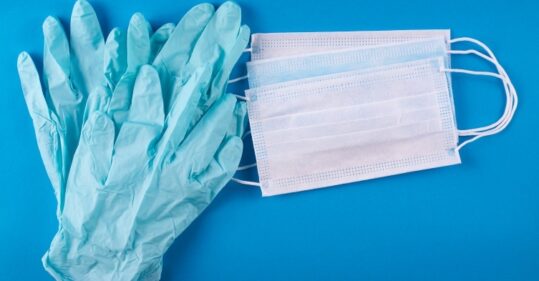Infection prevention and control guidance for Covid vaccine, including PPE procedures

As nurses will be carrying out much of the Covid vaccination work, Nursing in Practice has picked out key parts of the NHS’ novel coronavirus (Covid-19) standard operating procedure and Public Health England’s infection and control (IPC) guidance that should be useful for that. PHE has told Nursing in Practice nurses must closely follow guidance in these documents when administering Covid-19 vaccinations and must check it regularly to keep up with any changes.
Essentially: Healthcare workers must thoroughly wash/ sanitise their hands between patients and wear a fluid-resistant surgical facemask (FRSM), which they can wear for a whole clinical session. They should also wear gloves and aprons if they anticipate exposure to bloody/body fluids or non-intact skin. The gloves and aprons should be changed between appointments.
From NHS’s novel coronavirus (Covid-19) standard operating procedure:
2.6 Infection prevention and control (IPC)
The IPC guidance states that for administration of vaccines, healthcare workers must perform hand hygiene between patients and wear a sessional fluid-resistant surgical facemask (FRSM).
A patient and procedure risk assessment for vaccine administration may be completed (as recommended by the IPC guidance) to consider the likely risk of exposure to blood, body fluids and respiratory droplets, which in turn will inform the need for any additional PPE. This should take into account factors such as the prevalence of Covid-19 infection in their locality, the health status of the person being vaccinated, the route of administration, model of delivery and any relevant environmental factors; If further advice is needed, contact your local infection prevention and control team.
From PHE’s IFC guidance:
5.1 Personal Protective Equipment (PPE)
Related Article: NMC seeks nursing leader to oversee Code and revalidation reviews
All PPE should be:
• located close to the point of use (where this does not compromise patient safety, for example, mental health/learning disabilities). In domiciliary care PPE must be transported in a clean receptacle
• stored safely and in a clean, dry area to prevent contamination
• within expiry date (or had the quality assurance checks prior to releasing stock outside this date)
• single use unless specified by the manufacturer or as agreed for extended/sessional use including surgical facemasks
• changed immediately after each patient and/or after completing a procedure or task
• disposed into the correct waste stream depending on setting, for example domestic waste/offensive (non-infectious) or infectious clinical waste
• discarded if damaged or contaminated
• safely doffed (removed) to avoid self-contamination. See here for guidance on donning (putting on) and doffing (removing)
• decontaminated after each use following manufactures guidance if reusable PPE is used, such as non-disposable goggles/face shields/visors
Gloves must be:
• worn when exposure to blood and/or other body fluids, non-intact skin or mucous membranes is anticipated or likely
• changed immediately after each patient and/or after completing a procedure/task even on the same patient
• never decontaminated with Alcohol Based Hand Rub (ABHR) or soap between use NB. Double gloving is NOT recommended for routine clinical care of Covid-19 cases and vinyl medical gloves should only be worn in care situations where there is no anticipated exposure to blood and/or body fluids
Related Article: Tell us what practice nursing means to you and potentially win £1,000
Aprons must be:
• worn to protect uniform or clothes when contamination is anticipated or likely
• worn when providing direct care within 2 metres of suspected/confirmed Covid-19 cases
• changed between patients and/or after completing a procedure or task
Full body gowns or fluid repellent coveralls must be:
• worn when there is a risk of extensive splashing of blood and/or body fluids
• worn when undertaking aerosol generating procedures
• worn when a disposable apron provides inadequate cover for the procedure or task being performed
• changed between patients /individuals and immediately after completing a procedure or task unless sessional use is advised due to local/national data
Related Article: MPs vote to legalise assisted dying in England and Wales
Eye or face protection (including full-face visors) must:
• be worn if blood and/or body fluid contamination to the eyes or face is anticipated or likely – for example, by members of the surgical theatre team and always during aerosol generating procedures, regular corrective spectacles are not considered eye protection
• not be impeded by accessories such as piercings or false eyelashes
• not be touched when being worn.

See how our symptom tool can help you make better sense of patient presentations
Click here to search a symptom




